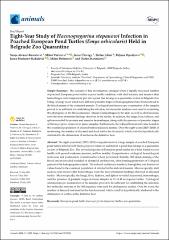| dc.contributor.author | Aleksić-Kovačević, Sanja | |
| dc.contributor.author | Vučićević, Miloš | |
| dc.contributor.author | Özvegy, József | |
| dc.contributor.author | Jelisić, Stefan | |
| dc.contributor.author | Đurđević, Biljana | |
| dc.contributor.author | Prodanov-Radulović, Jasna | |
| dc.contributor.author | Došenović, Milan | |
| dc.contributor.author | Marinković, Darko | |
| dc.date.accessioned | 2023-08-30T08:32:11Z | |
| dc.date.available | 2023-08-30T08:32:11Z | |
| dc.date.issued | 2023 | |
| dc.identifier.citation | Aleksi´c-Kovaˇcevi´c, S.; Vuˇci´cevi´c, M.; Özvegy, J.; Jelisi´c, S.; Djurdjevi´c, B.; Prodanov-Radulovi´c, J.; Došenovi´c, M.; Marinkovi´c, D. Eight-Year Study of Haemogregarina stepanowi Infection in Poached European Pond Turtles (Emys orbicularis) Held in Belgrade Zoo Quarantine. Animals 2023, 13, 2429. https://doi.org/10.3390/ ani13152429 | en_US |
| dc.identifier.issn | 2076-2615 | |
| dc.identifier.uri | https://repo.niv.ns.ac.rs/xmlui/handle/123456789/690 | |
| dc.description.abstract | The eight-year study (2015–2023) was performed on a large sample of poached European
pond turtles infected with Haemogregarina stepanowi and held in a pond that belongs to a quarantine
section of Belgrade Zoo. The protected species of European pond turtles have been found in poor
health, with general weakness, anorexia, and low motility. Comprehensive cytological, hematological,
molecular, and postmortem evaluations have been performed. Initially, Diff Quick staining of the
blood smears revealed rounded or elongated erythrocytes, often bearing premeront or U-shaped
gamont of the hemogregarines inside. The reduced erythrocyte numbers, hemoglobin, and hematocrit
values found in the examined population of infected turtles indicated anemia. Macroscopically, shell
necrosis and massive skin hemorrhages were the most prominent findings observed in diseased
turtles. Microscopically, the lungs, liver, kidneys, and spleen revealed hyperemia, hemorrhages,
and the presence of parasitic stages in tissue samples in 31 of 40 necropsied turtles. Cytological
and microscopic examination of the samples proved to be sufficient for establishing the infection,
but molecular analyses of the 18S sequence were used for phylogenetic studies. Over the years, the
number of diseased and dead turtles has decreased, which could be hypothetically attributed to the
elimination of leeches as the definitive host. | en_US |
| dc.description.sponsorship | The study was supported by the Ministry of Science, Technological Development and
Innovation of the Republic of Serbia (Contract number 451-03-47/2023-01/200143). | en_US |
| dc.language.iso | en | en_US |
| dc.source | Animals | en_US |
| dc.subject | European pond turtle | en_US |
| dc.subject | Haemogregarina stepanowi | en_US |
| dc.subject | Serbia | en_US |
| dc.subject | zoo quarantine | en_US |
| dc.title | Eight-Year Study of Haemogregarina stepanowi Infection in Poached European Pond Turtles (Emys orbicularis) Held in Belgrade Zoo Quarantine | en_US |
| dc.type | Article | en_US |
| dc.identifier.doi | 10.3390/ani13152429 | |
| dc.citation.volume | 13 | en_US |
| dc.citation.issue | 2429 | en_US |
| dc.citation.rank | M21a | en_US |
| dc.type.version | published | en_US |

